Retrospective Formats, Games & Ideas
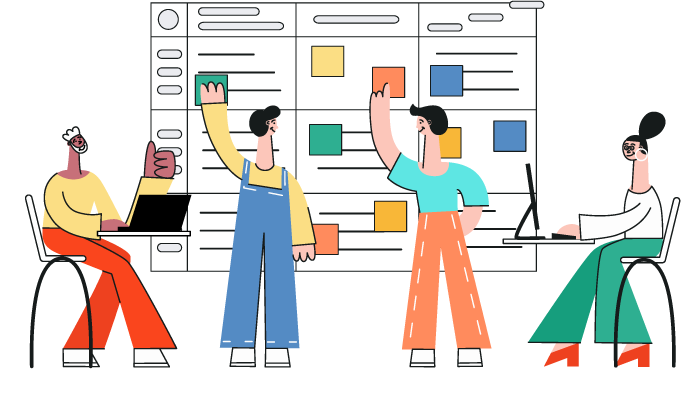

The sprint retrospective is an opportunity for the scrum team to inspect itself and create a plan for improvements to be enacted during the next Sprint.
The sprint retrospective occurs after the sprint review and prior to the next sprint Planning.
During the sprint retrospective, the team discusses:
- What went well in the Sprint
- What could be improved
- What will we commit to improve in the next Sprint
During each sprint retrospective, the scrum team plans ways to increase product quality by improving work processes.

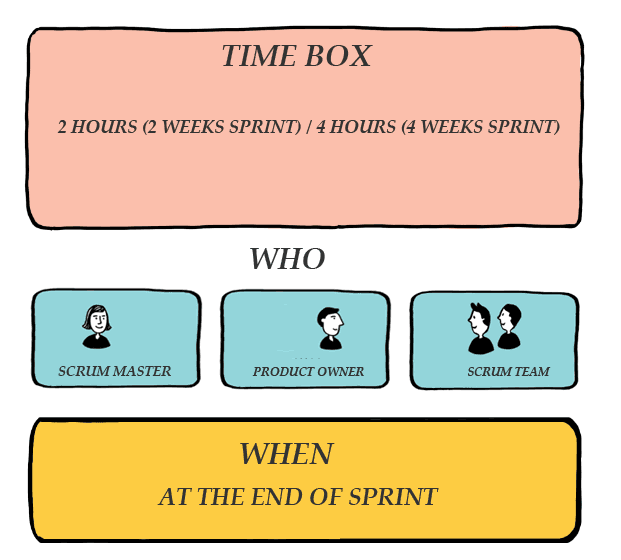
Sprint Review:
The sprint review looks at what the team is building, It is intentionally kept very informal, typically with rules forbidding the use of PowerPoint slides and allowing no more than two hours of preparation time for the meeting.
Sprint Retrospective:
The sprint retrospective meeting looks at how the team is building stuff. The sprint retrospective is usually the last thing done in a sprint.
The greatest benefit of retrospective meetings is that it provides the team with a scheduled opportunity to reflect on the recent and past events, choices, procedures, and behaviors so each can be sustained or changed as the team desires.
Successes and positives can be pointed out, checked for relevance, celebrated, or reinforced. Mistakes and disappointments can also be called out and assessed.
In short
Retrospectives provide platform to celebrate success and ponder upon failures

An Agile Retrospective is a ritual that enables teams to create a continuous improvement culture, where they reflect on past experiences and define future actions.
Following are some of the benefits of doing retrospective meetings at the end of each sprint
- The retrospective is a collaborative process among all members, including the team, the product owner, and the scrum master.
- All the team members discuss the process and give suggestions for its improvement.
- All team members identify what went well and what could be improved.
- The scrum master prioritizes actions and lessons learned based on team direction.
- The scrum master prioritizes actions and lessons learned based on team direction.
- The retrospective supports team formation and bonding, particularly as any areas of conflict can be identified and dealt with.
- The retrospective helps build the team's sense of ownership and its self-management.
source: www.youtube.com/watch?v=FJezcyKno5k
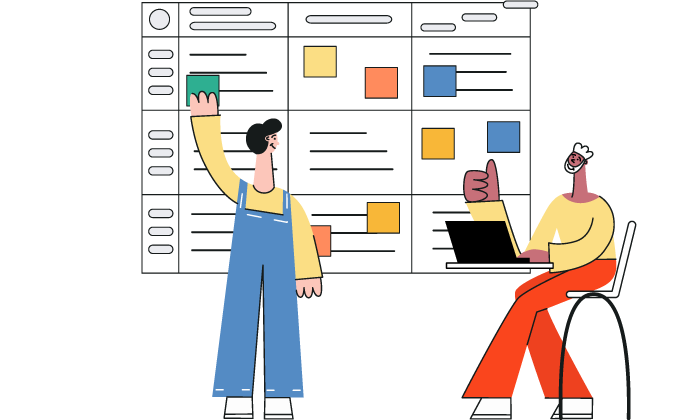
Agile retrospective meetings can be run in different formats. What kind of retrospective meeting format you should choose, depends on your team's preferences. Each retrospective formats has its own rhythm. You might consider experimenting with various types to test which model fits your team well.
In the following section we will go in details for each of these formats.
Start, Stop, Continue is an action-oriented retrospective technique that encourage participants to come up with practical ideas for team-based improvement. The team should think for the following three topics
Start What activities the team should start doing in the next sprint.
Stop What activities the team should stop doing in the next sprint.
Continue What activities the team should continue to do in the next sprint.
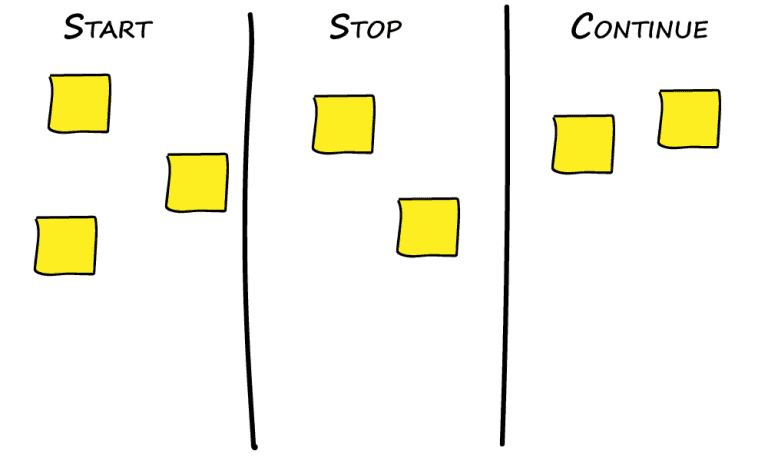
- The team gets an opportunity to review how they are doing, and identify improvements they can implement in the future.
- Make it easier for the teams to clarify issues, weight the impact of ideas, and reach a consensus based on shared priorities.
- Is very action orientated and provides momentum and energy for the team. Each item on the list results in behavioral change.
- All kinds of project teams including software development.
- Sprint reviews
- Program reviews
- Performance evaluations
A start stop continue retrospective is one of the simplest review tools. To successfuly execute it. You need to follow a three step process.
Identification:All the team members think about what actions they should start, stop, and continue doing as a team.
Each team member is encouraged to find items for each of the above colums. All these insights from all the members are created as items. If two team members came up with related points. They can be combined into one.
Once feedback from each team member is collected. The whole team goes through them one by one.
Voting:It is not possible for the team to follow all the items. The team needs to pick top three items from each column (Start, Stop, Continue).
This is achieved by using voting. Each team member gets three-five votes. He can spread it to items he thinks are more important. Or give all the votes to single item.
Items with most votes from each column get selected as focus points for next sprint
Sharing:The last step is to compile and distribute a report on the retrospective outcomes to the team.
Retrospectives are a way for the agile teams to continously improve the development proces. And the Start, Stop and Continue is one of the most perfect retrospective formats to achieve this.
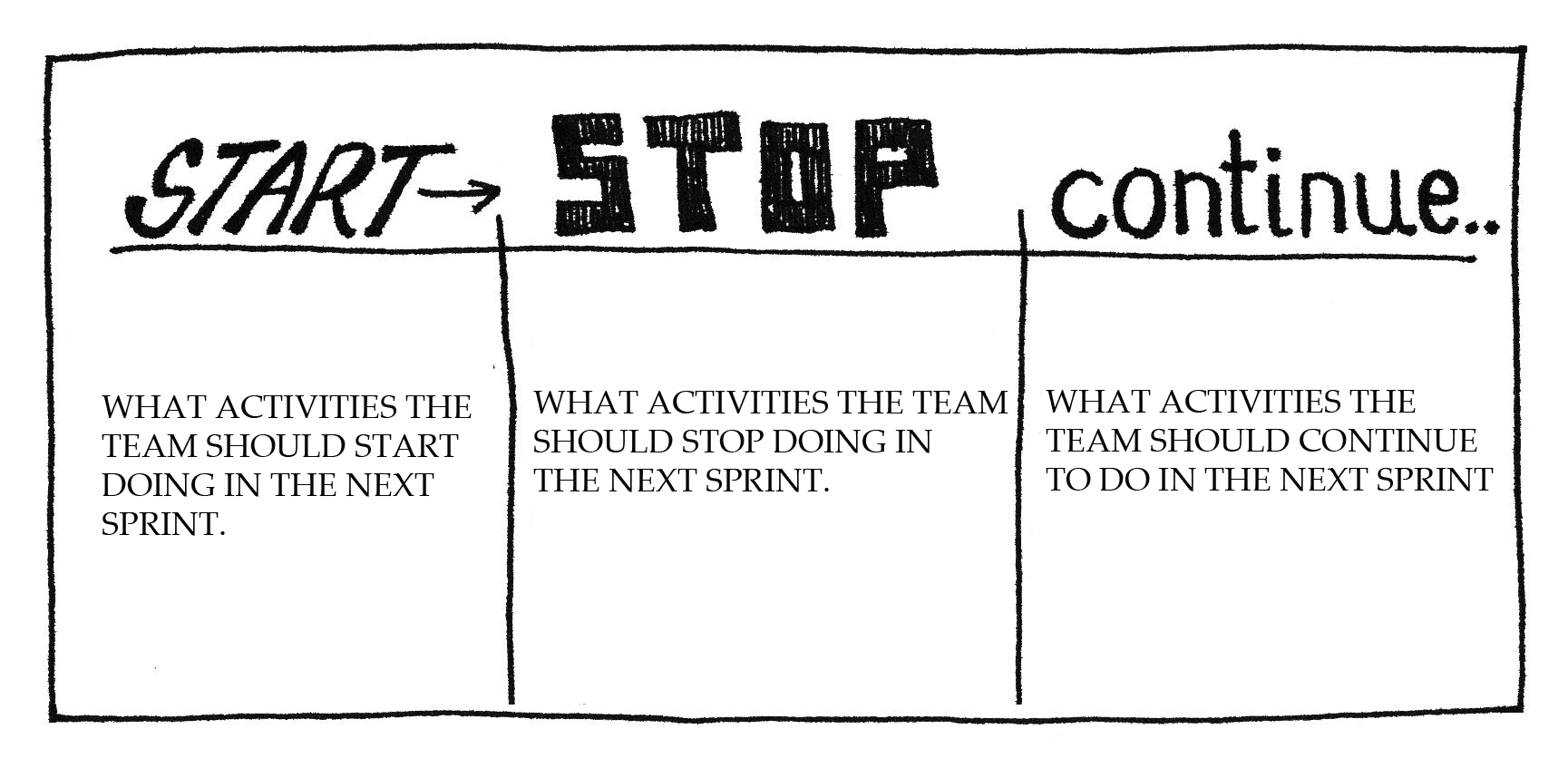
What Went Well? What Didn't Go Well? is a basic retrospective technique that focuses on your team's strengths and weaknesses.
- What Went Well? What Didn't Go Well? retrospectives are very easy to run. Following are the steps needed for its successful execution
Preparation:Before the retrospective starts the facilitator should hang two posters on the wall: one for "What Went Well?" and one for "What Didn't Go Well?".
Ideation:Retrospective facilitator hands out sticky notes to the team members. Participants should keep their sticky notes private so that theys aren't biased by each other's ideas. When the timebox expires, the participants should place their sticky notes on the appropriate poster boards on the wall.
Grouping:Since many observations will likely contain related (or even identical) ideas, participants should group sticky notes into logical themes.
Dot Voting:The team can opt to use dot voting to prioritize the discussion based on the collective desires of the group. The items which receives the most votes are chosen as the focus points for next sprint
Focus the team on creating a list of concrete actions it can take to improve.
Take a logical view of what's working and what's not.
In What Went Well? What Didn't Go Well retrospective format focus is on the strengths and weaknesses of the team.
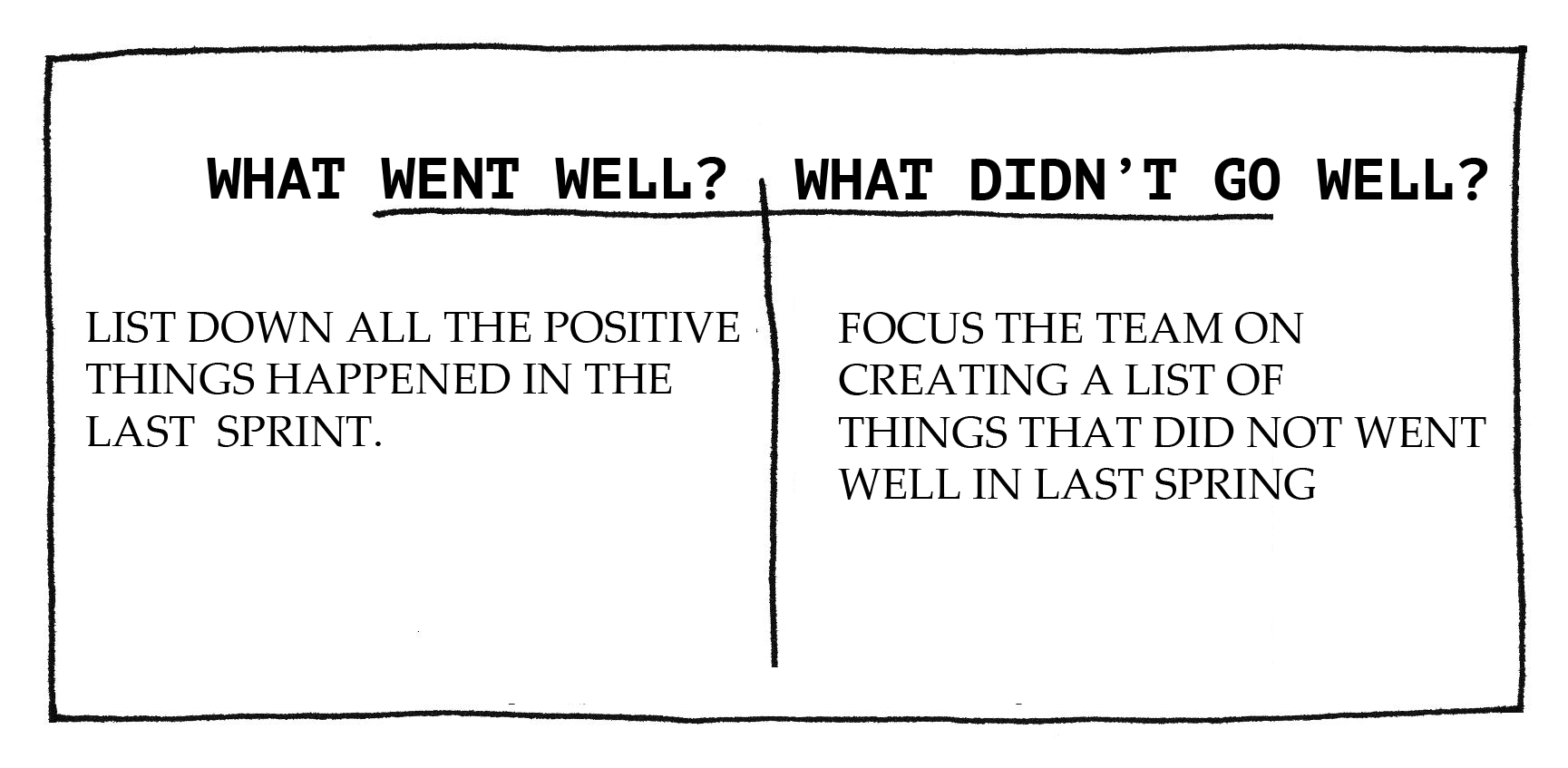
The mad sad glad retrospective encourages the team members to think about their emotional journey during the previous sprint, and is a great way to identify opportunities to improve team morale and job satisfaction.
This mad sad glad style retrospective encourages your team to be more emotionally aware to help build a positive team dynamic, and provides an opportunity to reflect on issues and opportunities from a different perspective.

- Following are the three main components
Mad:List the things that are driving you crazy. What is stopping you from performing at your best
Sad:What are some of the things that have disappointed you or that you wished could be improved?
Glad:What makes you happy when you think about this project? What are the elements that you enjoy the most
Focus the team on creating a list of concrete actions it can take to improve.
Take a logical view of what's working and what's not.
source: https://youtu.be/lXTEn4iV_Yg
Lean Coffee is a structured, but agenda-less meeting. Participants gather, build an agenda, and begin talking.
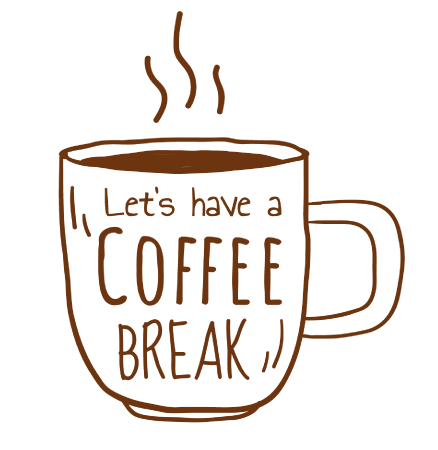
In lean coffee conversations are directed and productive because the agenda for the meeting was democratically generated.
Preparation:Before the retrospective starts the facilitator should set up a kanban board with three columns:
-To Do
-Doing
-Done
Ideation:The facilitator should hand out sticky notes to the participants. Participants should keep their sticky notes private so that participants aren't biased by each other's ideas. When the timebox expires, the participants should place their sticky notes in the "To Do" column on the kanban board.
Dot Voting:The facilitator should announce the timebox (5-10 minutes) and, if the team has never used dot voting before, explain how it works
Discussion:At the end all the team members discuss the final items to clear any doubts
- Have an open ended conversation that is entirely owned and directed by the team
- Ensure that the ideas the team collectively wants to emphasize are discussed at the beginning of the retrospective
In short Lean Coffee meetings are much more effective and enjoyable because it gives the control back over to those who can best use it. No longer is there one person dominating the conversation.With lean coffee invitees run the show, as it should be.
Sail boat retrospective is quite simple. First, we draw a SailBoat, rocks, clouds and couple of islands like it is shown on the picture on a flip chart.
The anchor on the SailBoat is everything that is slowing them down on their journey. The clouds and the wind represent everything that is helping them to reach their goal.
The islands represent teams goals/vision. They work every day to achieve these islands. The rocks represent the risks they might encounter towards their vision.
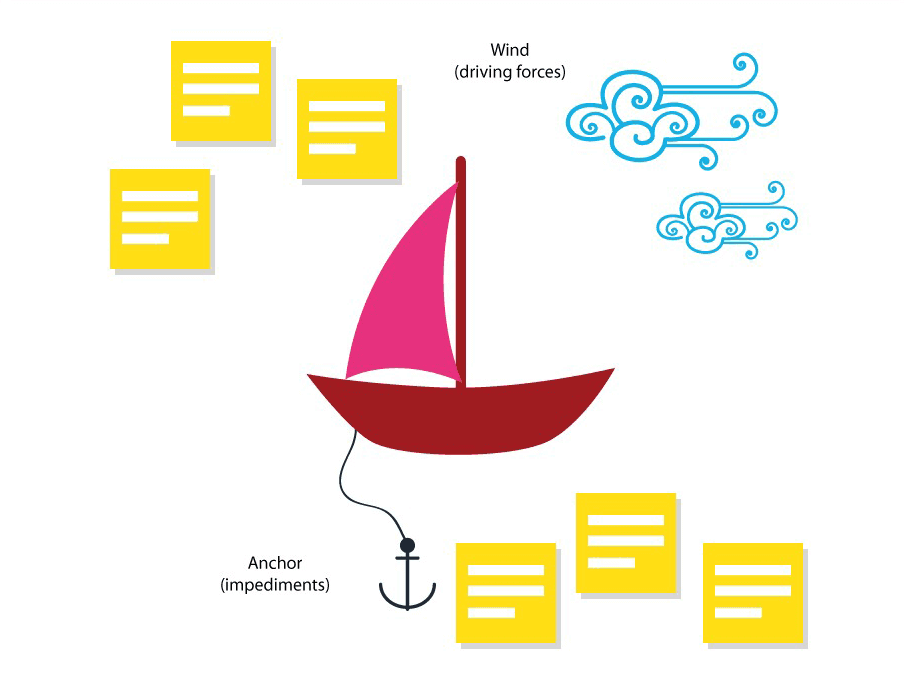
In short, Sail boat defines the vision for the team and identify any problems along the way.
-Show the team a picture of the sailboat describer above
-Explain that, similarly, a sprint has factors that slow it down and speed it up. The islands in the picture are the goals the team is heading to, the rocks are the risks they might face towards their vision.
-Write down what the team’s vision and goals are.
-Ask the team to record on sticky notes things that they felt helped the sprint move forward or slowed it down. Place the sticky notes either on the sail or below the boat, indicating that they are anchors or wind.
-Write down the ideas within the area of risks as well.
-Select a team member to group all the sticky notes on the board into similar categories.
-Get feedback from the rest of the team as to whether the grouping is fair, or if changes should be made.
-Have the team vote on what the team feels are the critical groups to focus on.
-Start root cause analysis and develop some outcomes.
4Ls is a popular, frequently used technique that is simple to set up for the facilitator and easy to understand for the participants
4Ls stands for Liked, Learned, Lacked, & Longed For
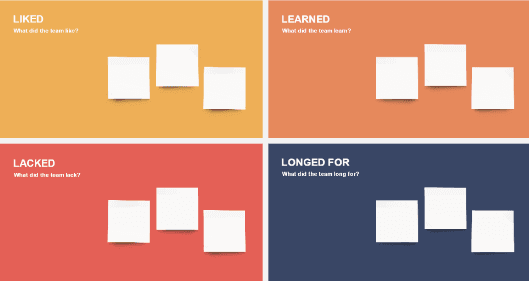
Liked:What did the team really enjoy about the sprint? In particular, what went better than expected? Emphasize the positive.
Learned:What new things did the team learn during the sprint? These can be technical things or nontechnical things.
Lacked:What things could the team have done better during the sprint?
Longed For:What things did the team desire to have during the sprint that were unavailable? Again, these can be technical or nontechnical
In Oscar retrospectives for persons each team member will be nominated for following categories, for example communication, personal motivation, leadership, good attitude and cooperation, good environment, capacity of solve problems, capacity and development
After the nomination all the participants will vote for each categories. After all the voting is done, Each team member will go through the top performing categories of all the participants.
In Oscar retrospectives for sprint team nominates stories for awards. These nominations can be e.g; best story , worst story or most annonying story.
Once the nomination is done. All the team members will vote and in the end the result will be discussed.
The iteration retrospective is used by Agile teams to reflect on the iteration just completed and to derive new ideas to improve the process
This helps instill the concept of relentless improvement—one of the pillars of the SAFe Lean-Agile Mindset—in the individuals and the team. And it helps ensure that every iteration yields some small improvements in the team’s process.
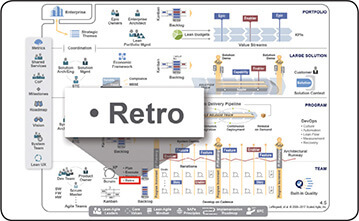
The whole team participates in the retrospective.The team conducts the retrospective in two parts
Quantitative reviewThe team assesses whether they met the Iteration Goals and this is a binary measure: yes or no.
They also collect any other metrics they agreed to analyze. This should include velocity—both the portion that is available for new development and the part devoted to maintenance.
Agile teams collect and apply other Iteration Metrics for visibility and to help with process improvement. This data is also the context for the qualitative section that follows.
Qualitative
First the team reviews the improvement stories they had identified in the prior retrospective, and then analyzes the current process, with a focus on finding one or two things they can do better in the next iteration
Since many improvement items have a significant scope, the team should divide them into smaller improvement stories, so that they can focus on what they can improve during an iteration.
Following are some of the popular iteration retrospective formats you can use.
Individual: Individually write Post-Its and then find patterns as a group
Appreciation: Note whether someone has helped you or helped the team
Conceptual: Choose one word to describe the iteration
Rating: Rate the iteration on a scale of one to five, and then brainstorm how to make the next one a five
Simple: Open a discussion and record the results under three headings
Below are some tips for holding a successful iteration retro
Keep the meeting timeboxed to an hour or less. Remember, it will come up every two weeks. The goal is to make small, continuous improvement steps.
Pick only one or two things that can be done better next time and add them as improvement stories to the team backlog, targeted for the next iteration.
The other targets for improvement can always be addressed in future iterations if they continue to surface in retrospectives.
Make sure everyone speaks.
The Scrum Master should spend time preparing the retrospective, as it’s a primary vehicle for improvement.
Focus on items the team can address, not on how others can improve.
To show progress, make sure improvement stories from the previous iteration are discussed either at the Iteration Review or the beginning of the quantitative review.
The retrospective is a private meeting for the team and should be limited to Agile team members only (Development Team, Scrum Master, and Product Owner).
A remote retrospective is simply a remote-friendly variation of the classic agile retrospective. Remote retrospectives are typically held with the help of video conferencing or tools like www.reetro.io.
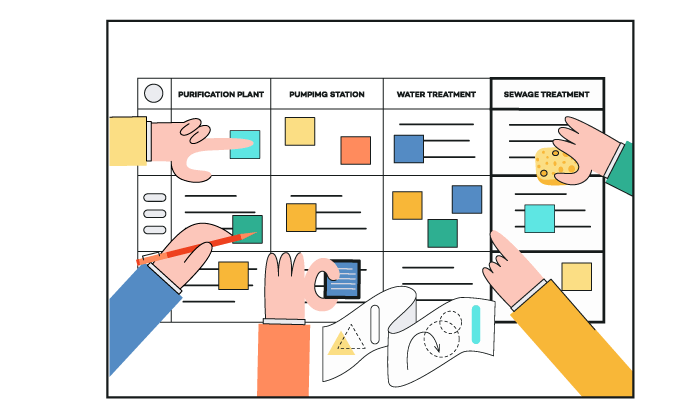
its goal is to allow the team to reflect on the work done and determine how they can use that knowledge to improve moving forward. It’s a great way to duplicate your successes and learn from your failures.
Track attendance and engagement:For a sprint retrospective to be worth the effort, the entire team must be involved. And it can be hard to get everyone involved because of technical reasons, meeting facilitation, or choosing the wrong tool or technique. It’s the scrum master’s job to ensure everyone stays engaged.
Review work completed:The entire retrospective should only take an hour and a half, with most of the time dedicated to discussion. To help your team remember the work that was done, provide a quick summary of the sprint in question. Mention key facts, such as what the plan was, how it was followed, and what the outcomes were.
Discuss:The discussion is the main part of any retrospective. It can be very open-ended, so to get proper outcomes being remote.
Actionable commitments:The main goal of the retrospective is to identify what actions must be taken in the next iteration. From the ideas discussed, the team should determine measurable actions that they can implement. For distributed teams, it’s especially important the actions are measurable.

In this section you can find various ideas to spice up your next retrospective meeting. These ideas have already been used at various small to big organizations.
In 1-word retrospective team members express their feelings by using just one word. Each team member need to tell, how he or she feels about the past iteration, summarized in one word.
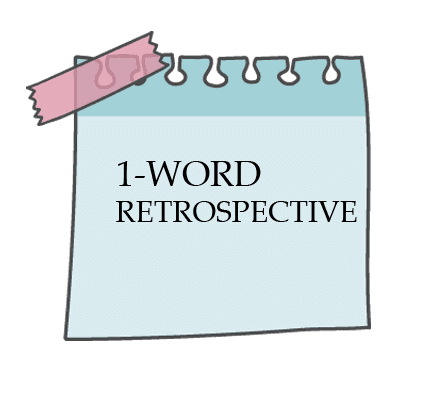
Facilitator needs to repeat each word and note them on a flip chart. If the words are written down, use why ask to clarify issues. Why does someone feel like that? Why does he or she think so about the iteration?
The team discusses the words that are applied and then decides which issues they will tackle and which improvement actions they will take.
It is important to work with the results. The team members take risks by discussing their feelings openly in the team.
They may therefore expect something to be done with what has been discussed. The team will always have to leave the room with the feeling that they have been listened to and that they have understood each other.
They need to feel that they are strong together and that they can solve the possible issues that exist together.
In this exercise participants draw some aspect of the sprint.
Distribute index cards, stickies and markers (or the digital equivalent) and markers. Set a topic, e.g. one of the following:
How did you feel during the iteration?
What was the most remarkable moment?
What was the biggest problem?
What did you long for?
Ask the team members to draw their answer. Post all drawings on a whiteboard. For each drawing let people guess what it means, before the artist explains it.
Metaphors open new viewpoints and create a shared understanding.
In this exercise the main purpose is to find. Are there unspoken taboos holding back the team?
Stress confidentiality. Announce the activity as silent and that all "evidence" will be destroyed afterwards.
Hand each participant a sheet of paper to write down the biggest unspoken taboo in the company or team. Or you can use collect the feedback mechanism in Reetro. It perfectly collects the feedback in anonymous manner.
When everyone's done, they pass their paper to their left neighbours. The neighbours read them and may add comments.
Papers are passed on until they return to their authors for a last review. Then all pages are ceremoniously shredded. Use with caution!
The feedback game gives you an insight on your own personality and can be used to start an in depth conversation about each other’s attitude and behaviour.
By using 140 cards with different characteristics you’ll be able to find an answer on questions like:
What are my qualities?
How do others perceive me?
What are qualities that I want/need to improve?
This game can be used for teambuilding, appraisals, coaching and counseling, career planning, development and personal strengths.
Place a sphere in the middle of free space and gather the team around it. The sphere represents the center of agreement. Move toward the center if you agree and outwards if you don't. Read out statements like:
I feel I can talk openly in this Retrospective
I am happy with the quality of our code
I feel I'm part of the best team ever
Two Truths and a Lie is a fun retrospective activity that I have used couple of times to ‘break the ice’ at group meetings.
What you can expect to get out of this exercise?
By using this retrospective technique, you will have promoted team collaboration to generate a praise report and define actionable retrospective items.
The praise report is used by the team to celebrate the successes of the previous sprint, while the action items are used to focus and rally the team around potential team improvement areas.
I am happy with the quality of our code
I feel I'm part of the best team ever
Rules
Each person will make three statements about the past Sprint – of which, two will be true and one will be a lie. Statements should be related to any likes/dislikes, experiences, skills or habits.
Introduce this scenario: "Imagine you could time travel to the end of the next iteration. You learn that it was the best, most productive iteration yet How do your future selves describe it?
What do you see and hear?" Give the team a little time to imagine this and jot down some keywords.
Then let everyone describe their vision of a perfect iteration. Follow up with "What changes did we implement that resulted in such a productive and satisfying future?" Write down the answers on cards for the next phase.

Following is a list of best practices you can use to improve the restrospective pre
Preparation:You should set the stage so every member of the team feels comfortable. It should be the team’s safe place. Send a Retrospective reminder. Book a meeting room, think about the retrospective meeting agenda.
People:Get the correct people in. It is beneficial if everybody in the team attends it, but it may not always happen.
Results:Start the conversation by reviewing the actions from the previous retrospectives .One of the keys of team motivation is to show the improvements made on previous Retrospectives.
Track attendance and engagement:For a sprint retrospective to be worth the effort, the entire team must be involved. And it can be hard to get everyone involved because of technical reasons, meeting facilitation, or choosing the wrong tool or technique. It’s the scrum master’s job to ensure everyone stays engaged.
Retrospective Games:Another technique is to incorporate games and other varying tactics into your sprint retrospectives.
There are a lot of examples out there. Pick one that makes the most sense for your team or project stage, and be sure to run through it at least once beforehand so you’re familiar. These can be fun, effective, and productive but only when the facilitator is prepared
Time:Timebox every section of a retrospective meeting.
Retro Battle: ask people to take randomly a particular side and fight for it.
Vote:Vote on the items in real time. Everybody has a restricted amount of voting. Sort item by votes. Imaging your meeting get suddenly
Actions:Propose actions for every important item.
Voteed Actions:If there are many actions you could vote to decide which one to tackle.
Accountability:Select an accountable person for each action. Let him drive the execution.
Tracking: Use issue trackers like Jira, Trello, Asana to track the progress of all actions.
Actions on boards: Add actions to the sprint or Kanban backlog otherwise you may not do them. Make them part of your routine work.
Deadline:Set the deadlines for actions.
Rotation: Change the retrospectives facilitator. Time to time or every time to increase team cooperation.
Use Reetro: Use high-quality tools like reetro if you have remote team members.
Video: Record video from your retro for future references or for people who could not make it.
Timing: Do them timely. It is a good cadence to do them every sprint, but many teams do them monthly.
Frequency: Do them more often if your team is new. If your team is morphing often or many people join every few months. It makes sense to have a short retro before the sprint to review a few previous retrospectives.
What's next: Create next retrospectives artefacts after you finish the current one. It will help people to note the input down and they don’t forget it.
Randnomness: Invite random people from your organization. The experts who you believe can improve processes. Like experts in Design Sprints.
Participate: Attend retros of others to gain knowledge how they do them.
Finish early: As any other meeting, don’t hesitate to finish it earlier if you can.
Chart: Make a retrospectives burn-down chart which compares progress over the last few meetings. 5 to begin with.
Happiness: Measure happiness factor and watch it over time.
Feedback: Use feedback cycle to improve the effectiveness of retrospectives.
Retro for retro: Once in a while do retrospective for retrospective meetings (can be a smaller team and less often).
Tools: Use tools that facilitate collaboration. Something like Reetro will do.
Be obsessed: Be obsessed about improving.
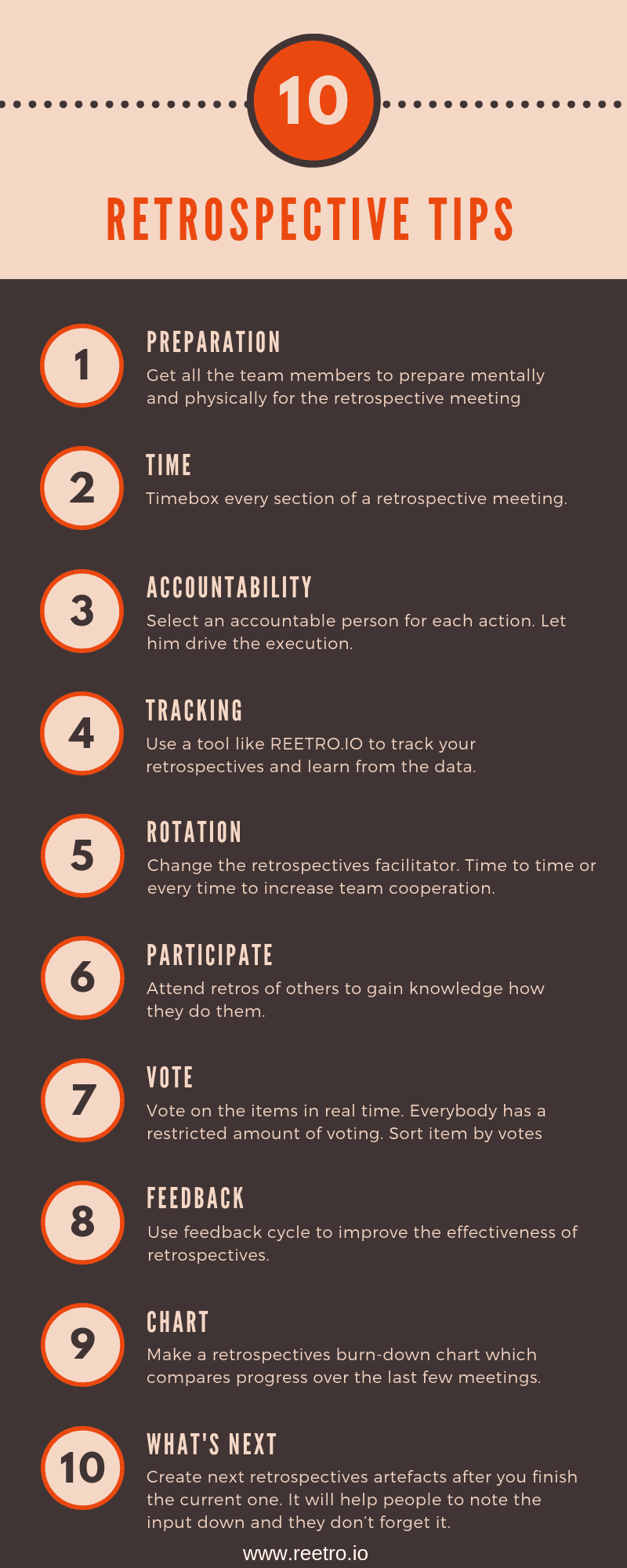

Agile retrospectives could help teams learn from the past and identify improvement opportunities. The simplest way to conduct retrospectives is to collect everyone involved in the team in one big room.
But how to capture and spread learnings from big complex multi-site efforts involving dozens of teams, with hundreds of people spread across different continents that’s a logistical nightmare.
This was the exact problem folks from spotify faced when they grew at a rapid pace. Growing from few hundreds to few thousand’s.
In order to overcome these problems they formed their own format to run large scale de -centralized retrospectives.
This model has become an industry benchmark for running large scale distributed retrospectives. In this case study we will explore how exactly spotify achieved this.

Step 1- Team Formation: begins with emailing agile coaches to seek volunteers to form a small working group of facilitators.
Once the group is formed, most of the activities revolve around setting expectations, creating an objective for the retro, communicating to the company and participants about the retro as heads-up.
Step 2 – Doing the actual retrospectives: Not everyone is involved in every conversation, instead smaller groups are formed to conduct smaller conversations.
The facilitators spread out, pick a theme, gather a cross-section of people that have insights into that theme, and run a retrospective.
Smaller groups make for better conversations, and also easier logistics (easier to find a time that works, a room that fits people, etc).
As for the specific format,they have formed a “standard” format, which gives the facilitator a starting point and also makes for easier merging later:
Introduction (purpose of this retro, introduce each other)
Timeline (draw a timeline together, annotate with milestones, what worked well, what didn’t, and any “elephants”)’
Cluster (find patterns and label them)
Recommendations (distill into concrete insights and recommendations, both for the how we work now, as well as how we might work in the future)
Closing (round-table final thoughts from people, and quick feedback about the retro itself) Pretty standard retro format.The working group meets up from time to time, using the spreadsheet above as a sync and status tool. They support each other and address problems such as lack of facilitators.
As individual retros are wrapping up (after a few weeks typically), the working group gradually transitions into next step.
Step 3 – Discussing and merging the collected data: The goal is to find patterns and condense it into a short and coherent summary with key insights and recommendations. When ready, the working group enters the last phase
Step 4 – Spreading the word: That includes things like sharing the summary with stakeholders and retro participants; meeting in small groups to share learnings; speaking during town hall sessions; and so forth to really help the organization internalize and act and upon the learnings.
What spotify learned with this distributed retro model at scale is that it enables different groups to focus on different topics deeply to generate cross functional and impactful learnings across the company.
On the human level it provides a great venue and increased engagement for folks to have their say, get their voice heard, and just as importantly a neutral safe place to air dirty laundry.
You can read the original blog post at : https://labs.spotify.com/2015/11/05/large-scale-retros/

Following is a list of some of the best retrospective tools you can use to manage retrospectives. They offer different features and price points.
Reetro is the most powerful, fun and flexible tool in the world. Reetro makes it easier to plan, execute and analyze retrospectives. It uses push notifications to gather feedback from team members and seamlessly automates the retrospective prcess.
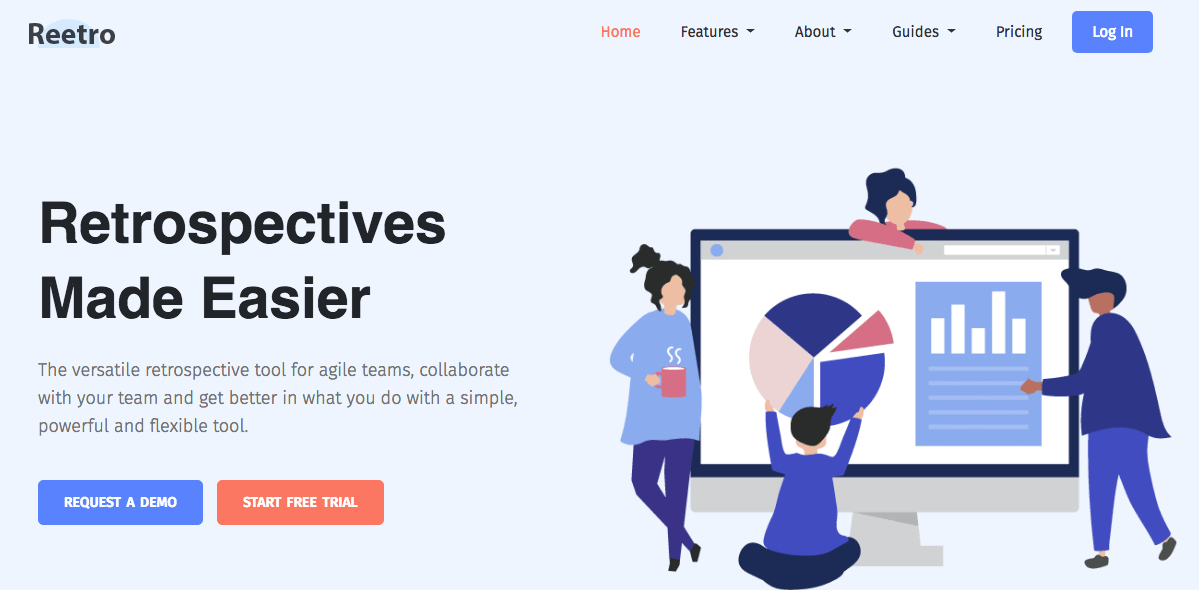
A clean and straightforward retrospective tool. FunRetro makes it effortless to run sprint retrospectives. It provides a free and a paid version and is easy to use.
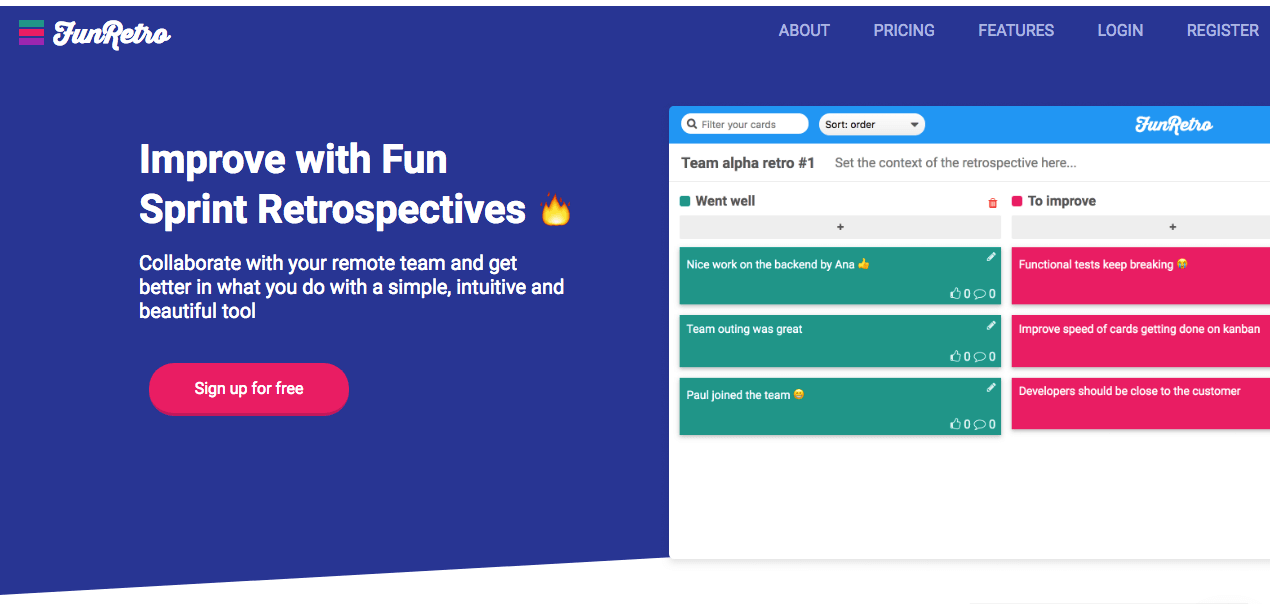
Keep your team engaged using Retrium's wide variety of facilitation techniques.Offers a 30 days free trial
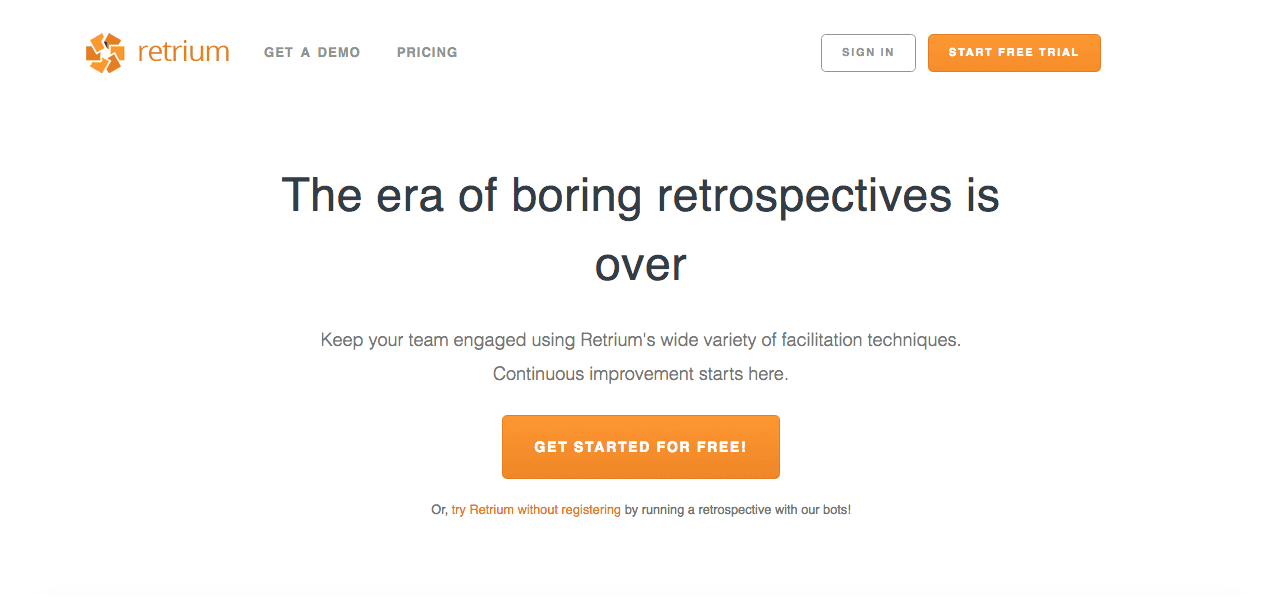
Parabol software is for agile teams, and anyone interested in creating systems of continuous improvement. It’s perfect for scrum masters and other leaders wanting to conduct a Lessons Learned meeting or team-building exercise.
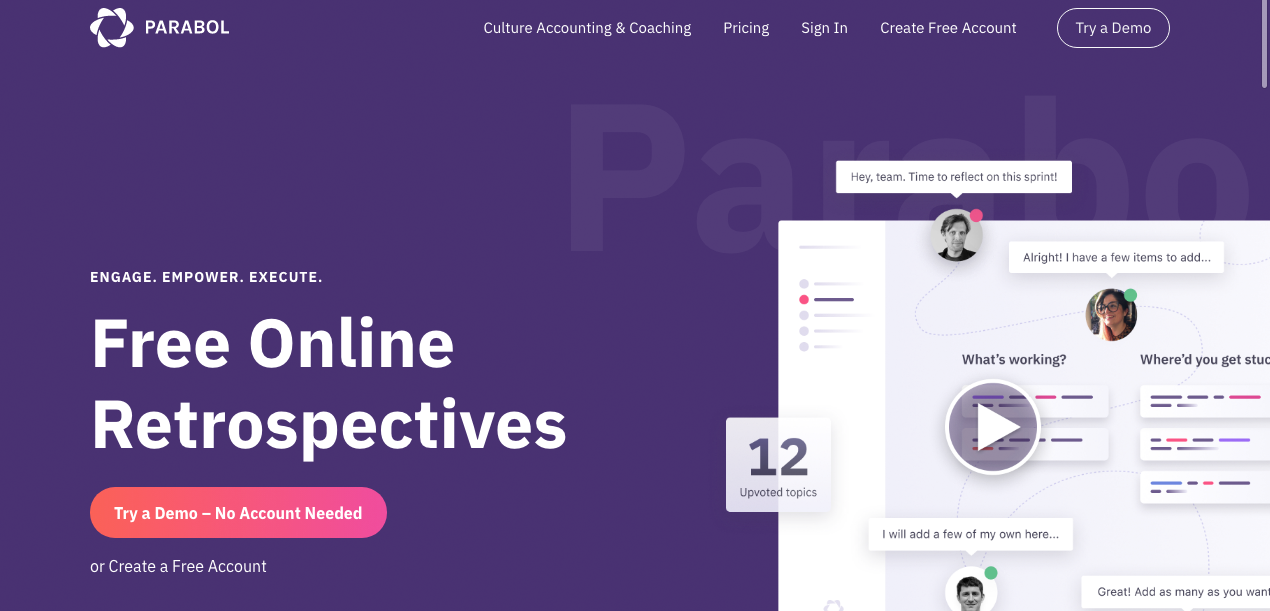
A fully featured sprint retrospective tool. Create a retrospective and invite your team, and start your retro. It's that simple. Once your team has completed feedback, show the comments and start the conversation on how to improve.
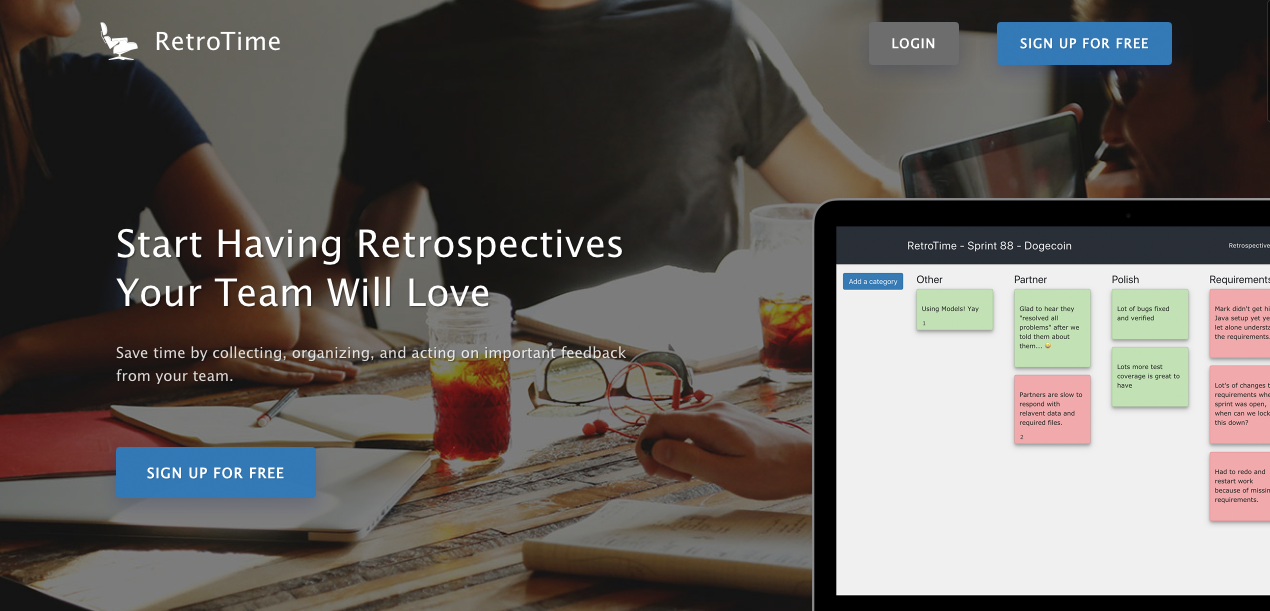
Why wait for the retrospective to share your ideas for improvement with your team? With goReflect, you can share ideas anytime, anywhere.
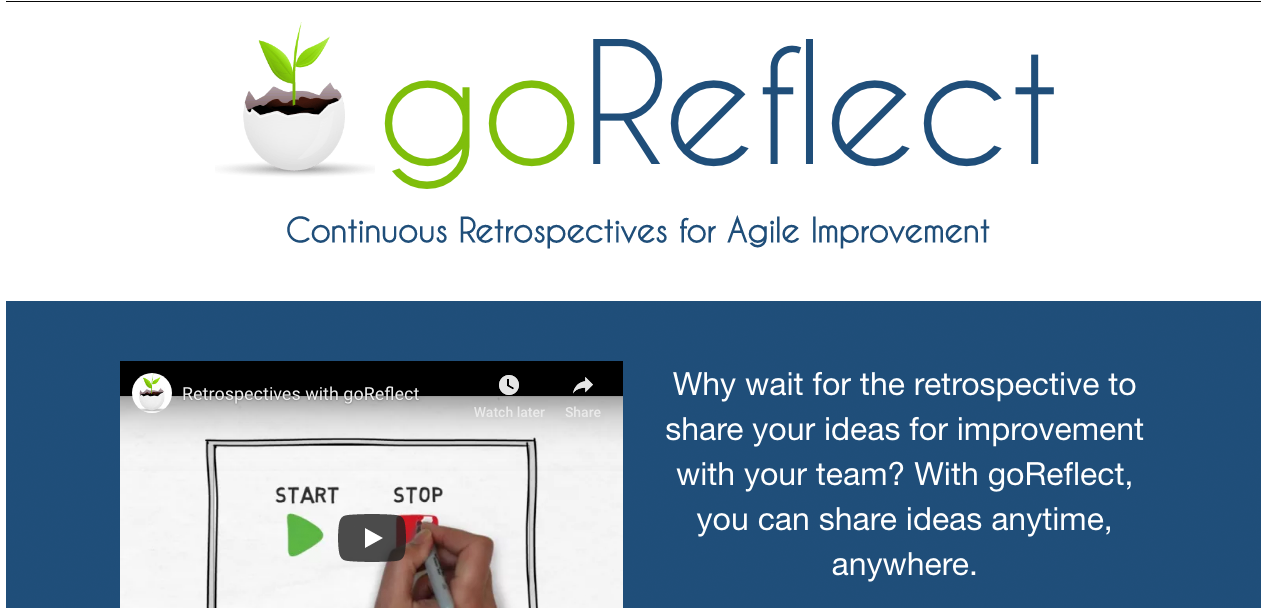
TeamRetro is an enterprise-ready online agile retrospective meeting tool for agile coaches, scrum-masters and teams. Experience the difference at your next retrospective meeting.
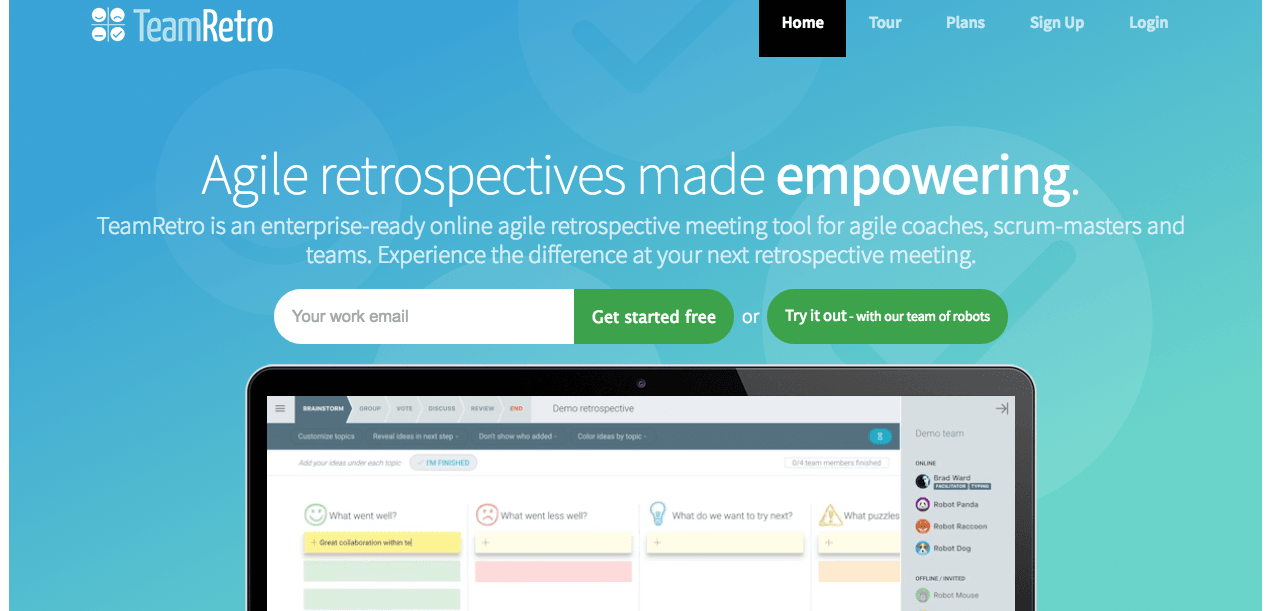
Fun, effective retrospectives for distributed agile teams. Encourage collaboration from every team member and follow up on every action. Sensei's simple retrospective flow and progress tracker guides teams toward a state of continuous improvement.
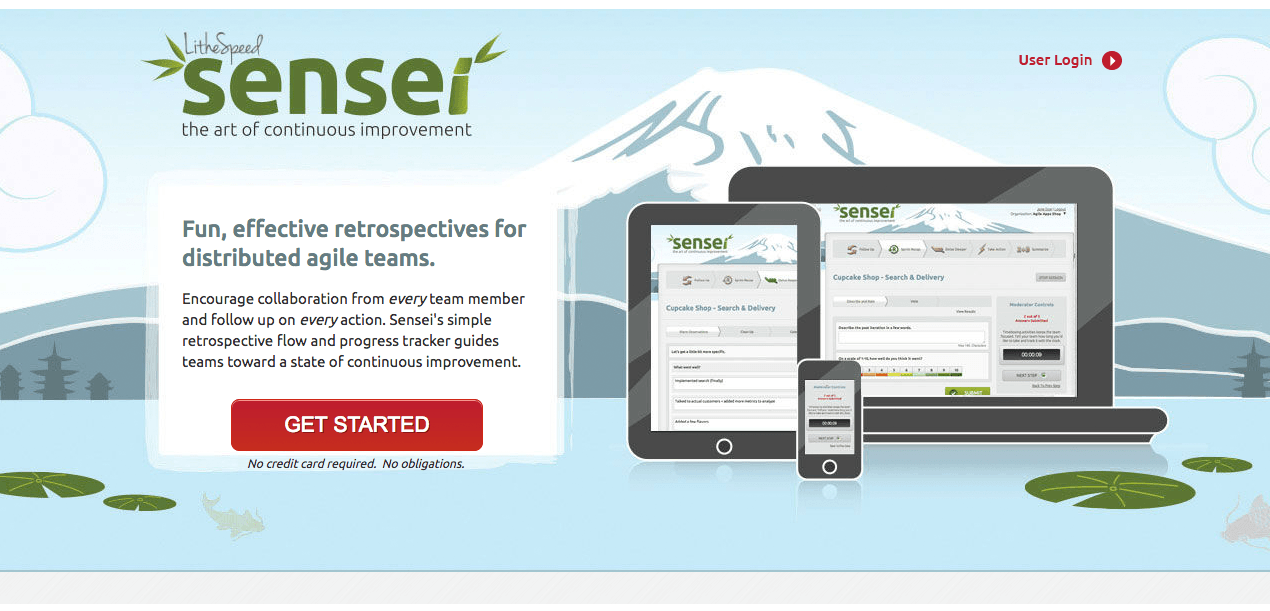
Following section contains a list of some of the best retrospective blogs on the internet.
Atlassian blog should be your go to source if you want to read some quality articles on Agile, SCRUM and Retrospectives.
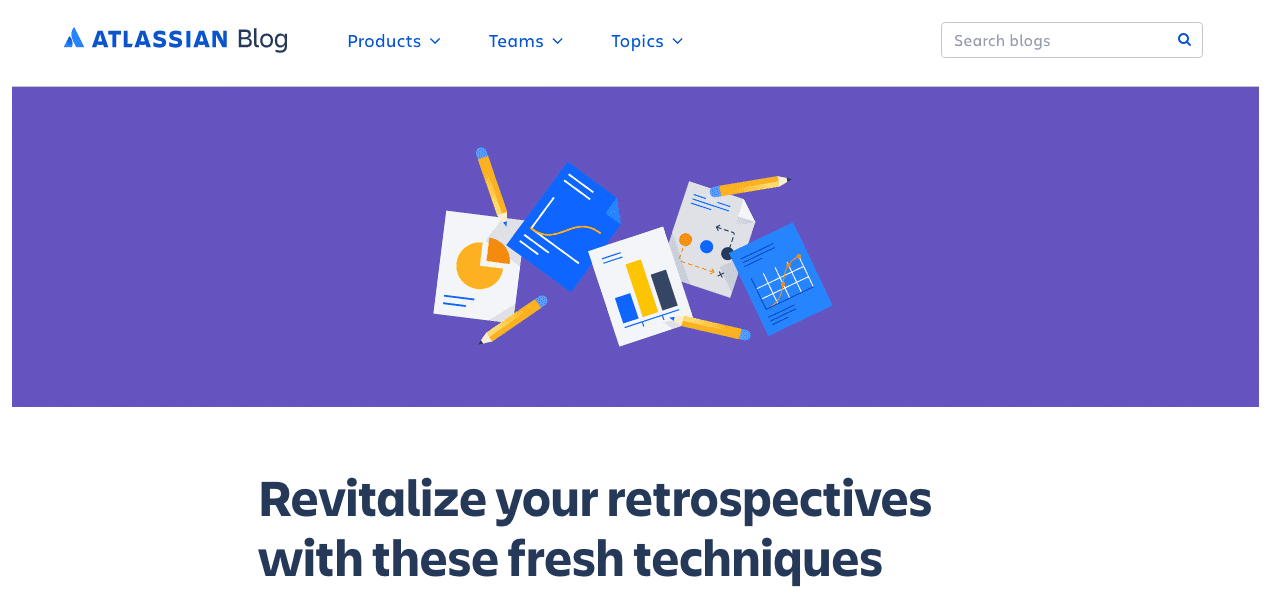
Scrum.org is also another high quality resource for all the agile and scrum related stuff. We at reetro regularly use this blog to learn about latest news in the scrum community.
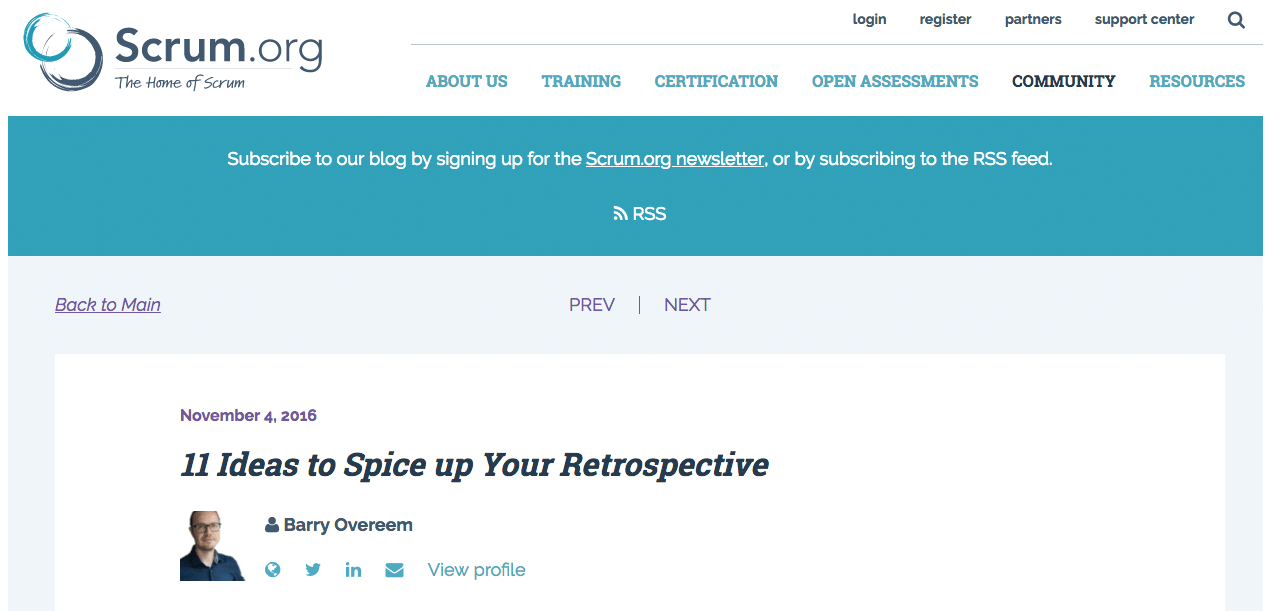
Yodiz's blog is another go to source for learning agile and retrospectives related stuff.
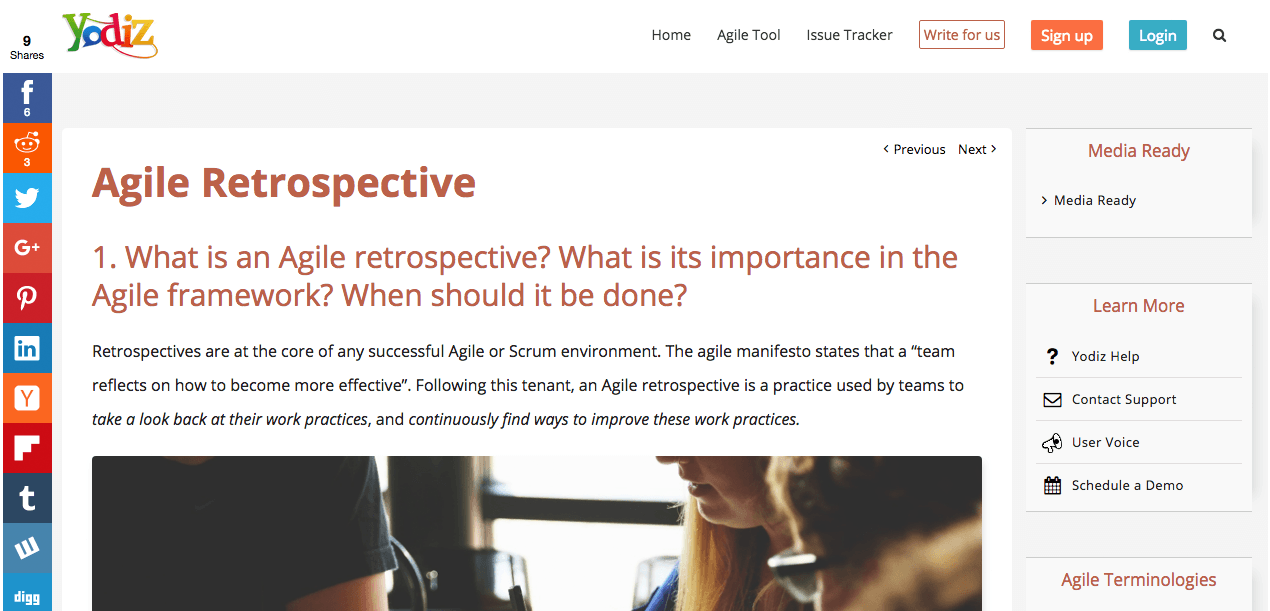
Luis Goncalves blog have many in depth guides on various agile related topics. His guide on retrospective is one of the best on the internet.
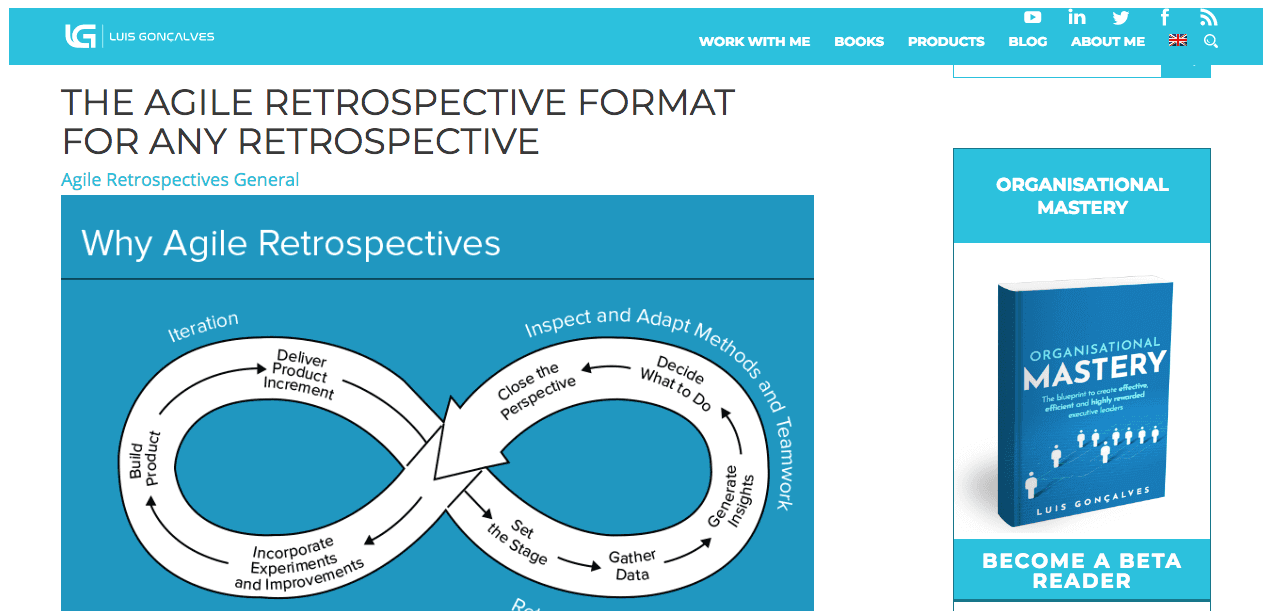
If you are looking to spice up your retrospectives. Read the following guide by agile strides
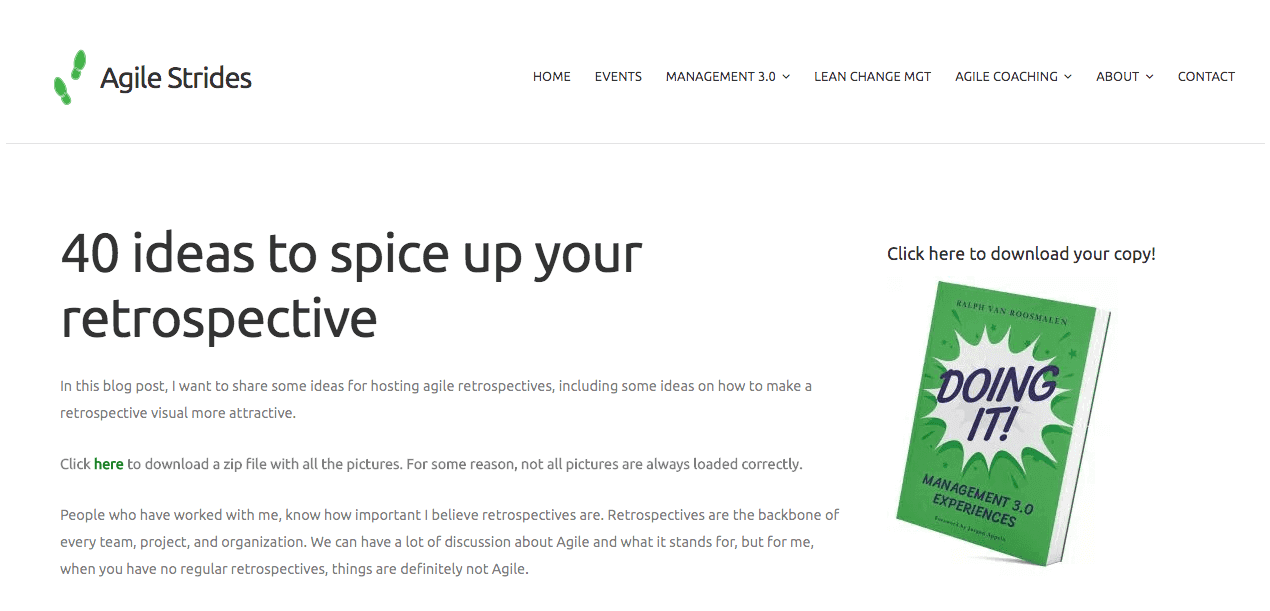
This book provides you a tool set of activities to transform a group of people into an effective team. Keeping the participants amused and providing a setting where they can reflect, discuss and have fun is fundamental to continuously improve.
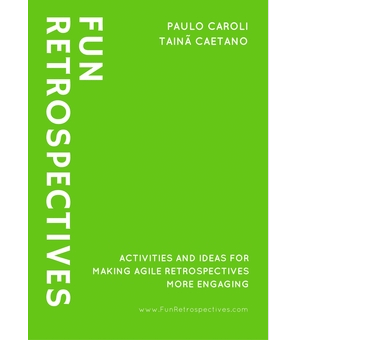
Learn how to improve retrospectives and avoid stagnation, with fifty ideas designed to help you enhance and energise your continuous improvement effort. This book will help you get better outcomes from retrospectives and from any continuous improvement initiative.
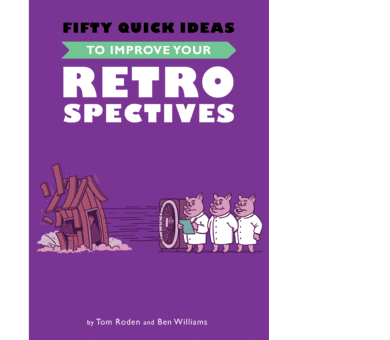
This book condenses down over eight years of experience working with the retrospective practice within the context of real agile teams. It offers you practical advice on how to make your retrospectives even more effective.
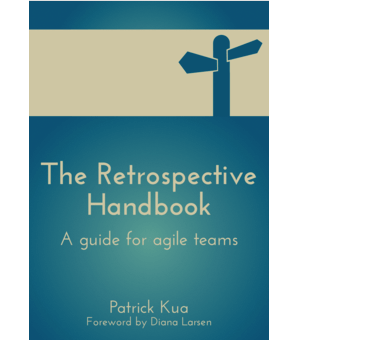
In this book, Jutta Eckstein examines how retrospectives –originally a kind of a facilitated workshop for gaining feedback– can be applied conceptually to initiate and implement organizational change.

This is a book for agile coaches, scrum masters, project managers, product managers and facilitators who already have some experience with retrospectives.
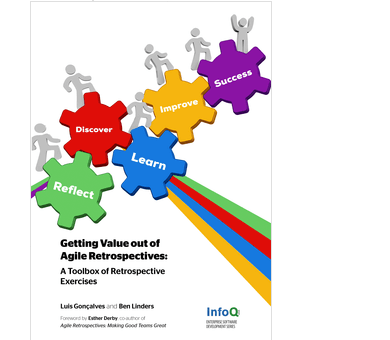

Retrospectives are one of the most important part of agile development. They provide a way for the whole team to reflect on the development and coordination process.
Every team has its own challanges and difficulties and retrospectives are a way to dissect these challanges and improve along the way.
Follwoing infograph shows the 5 most important steps of a retrospective.
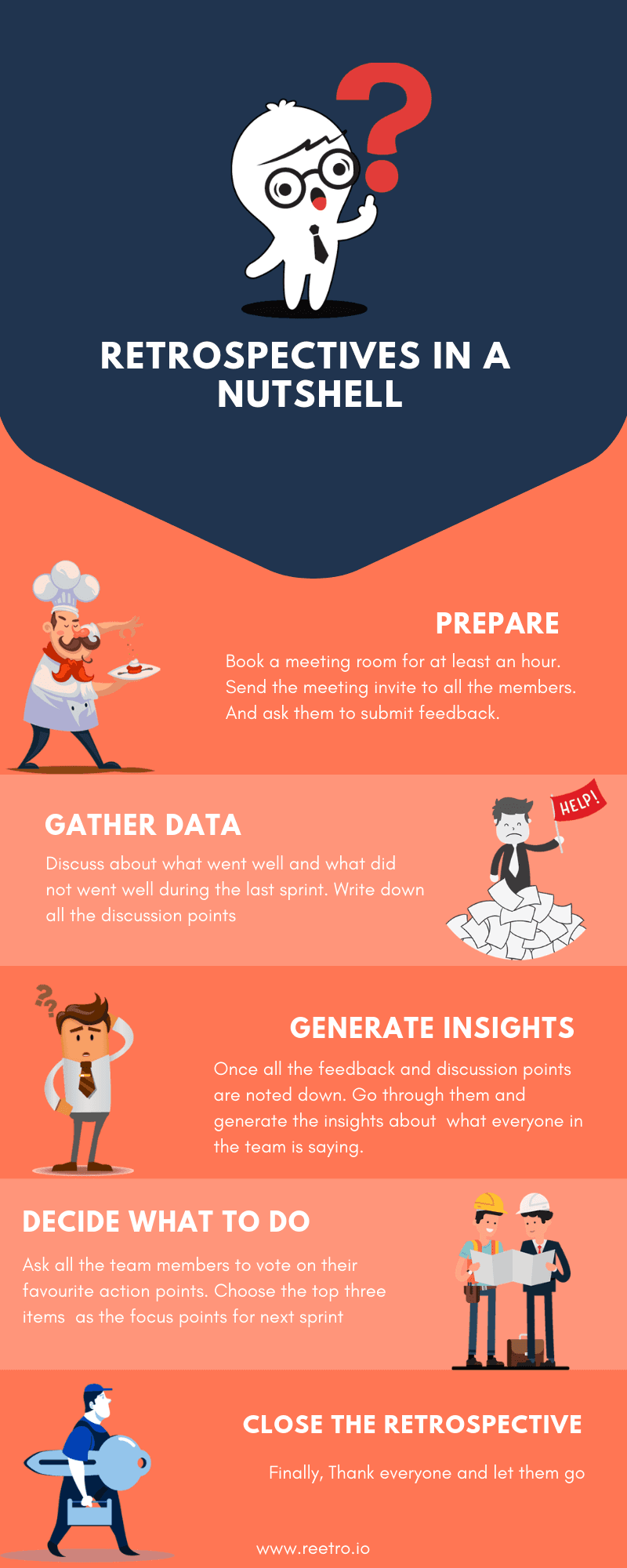

Download the guide here https://reetro.io/Retrospective-Guide.pdf
https://agilestrides.com/2017/09/25/40-ideas-to-spice-up-your-retrospective
https://www.scaledagileframework.com/iteration-retrospective/
https://dozylocal.wordpress.com/2014/09/30/story-oscars/
https://solidgeargroup.com/oscars-academy-awards-retrospective
https://www.atlassian.com/blog/jira-software/5-fun-sprint-retrospective-ideas-templates
https://www.retrium.com/resources/techniques/4ls
https://luis-goncalves.com/sailboat-exercise-sailboat-retrospective/
https://www.teamretro.com/techniques/mad-sad-glad-retrospective/
https://www.quickscrum.com/ScrumGuide/182/sg-Sprint-Retrospective-Meeting
https://www.mountaingoatsoftware.com/blog/a-simple-way-to-run-a-sprint-retrospective
https://hackernoon.com/42-ways-to-improve-retrospectives-e3067886c7f5
http://anagilemind.net/2017/11/21/favorite-retrospective-techniques/
https://www.scrum.org/resources/blog/11-ideas-spice-your-retrospective
